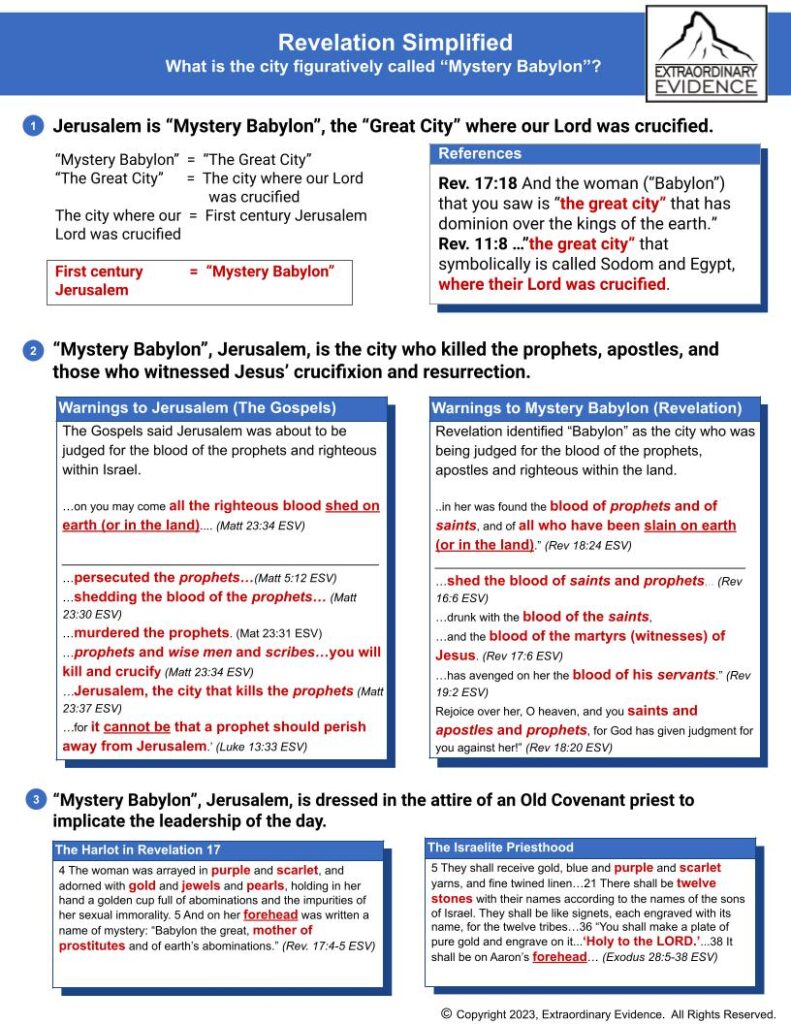The identity of Mystery Babylon in the Book of Revelation has been the subject of much debate and speculation for centuries. While some interpretations point towards future events or entities, the textual clues confirm the identity of Mystery Babylon as first century Jerusalem. This argument is grounded in a close reading of Revelation, particularly chapters 11 and 17, alongside historical accounts and relevant Old Testament passages.
The Stated Timing
The Book of Revelation opens and closes with warnings the events of the book were near in the time it was published.
Introduction – Revelation 1:1-3
1The revelation of Jesus Christ, which God gave him to show to his servants1 the things that must soon take place...
3 Blessed is the one who reads aloud the words of this prophecy, and blessed are those who hear, and who keep what is written in it, for the time is near.
Ending – Revelation 22: 6-20
6 And he said to me, “These words are trustworthy and true. And the Lord, the God of the spirits of the prophets, has sent his angel to show his servants what must soon take place.”…
7 “And behold, I am coming soon. Blessed is the one who keeps the words of the prophecy of this book.”…
10 And he said to me, “Do not seal up the words of the prophecy of this book, for the time is near…
12 “Behold, I am coming soon, bringing my recompense with me, to repay each one for what he has done. – ”
20 He who testifies to these things says, “Surely I am coming soon.” Amen. Come, Lord Jesus!- Revelation 22:7
The Bloodshed of Prophets and Witnesses
One of the most striking accusations against Mystery Babylon is its history of bloodshed, specifically the killing of prophets and those who witnessed the resurrected Jesus. Revelation 18:24 states, “And in her was found the blood of prophets and of saints, and of all who have been slain on earth.” This language echoes Jesus’s own condemnation of Jerusalem in Matthew 23:37, where he laments, “O Jerusalem, Jerusalem, the city that kills the prophets and stones those who are sent to it!” The text explicitly links the city’s impending destruction to its long history of persecuting God’s messengers. This connection is further strengthened by Revelation 17:6, which describes Mystery Babylon as “drunk with the blood of the saints, and with the blood of the martyrs of Jesus.” The term “witnesses” here refers specifically to those who saw the resurrected Jesus, as shown in definition provided in Acts 1:21-22., “men who have accompanied us all the time that the Lord Jesus went in and out among us—beginning with the baptism of John until the day that He was taken up from us—one of these must become a witness with us of His resurrection.” There is no one alive today who saw Jesus’s crucifixion and resurrection.
The Great City Where Our Lord Was Slain
Another crucial clue to Mystery Babylon’s identity is its designation as “the great city.” Revelation 17:18 states, “And the woman that you saw is the great city that has dominion over the kings of the earth.”4 This phrase is repeated in Revelation 11:8, which identifies “the great city” as “the city where their Lord was crucified.”4 Combining these verses leads to the conclusion that Mystery Babylon is the city where Jesus was crucified, which is undeniably first-century Jerusalem.
The Harlot’s Attire
The description of Mystery Babylon’s attire further solidifies the connection to first-century Jerusalem. Revelation 17:4-5 describes her as “arrayed in purple and scarlet, and adorned with gold and jewels and pearls, holding in her hand a golden cup full of abominations.” This imagery directly parallels the elaborate garments worn by the Old Covenant priests, as detailed in Exodus 28:5-38.5 The use of purple, scarlet, gold, and jewels aligns with the priestly attire, suggesting that Mystery Babylon is not just a city, but a religious system steeped in Old Covenant symbolism. The golden cup filled with “abominations” represents the corrupt practices including the guilt they would fill up by killing those sent to them as seen in Matthew 23:32-34, “Fill up, then, the measure of the guilt of your fathers….Therefore, behold, I am sending you prophets and wise men and scribes; some of them you will kill and crucify, and some of them you will flog in your synagogues, and persecute from city to city,”
Jerusalem’s Unfaithfulness
The term “harlot” used to describe Mystery Babylon points to spiritual unfaithfulness and idolatry. This label is consistent with how Jerusalem was often characterized in the Old Testament. Ezekiel 16:30 uses the same imagery, accusing Jerusalem of being “an adulterous wife, who takes strangers instead of her husband.” This metaphor underscores the city’s departure from its covenant with God and its embrace of foreign gods and practices.
Conclusion
While other interpretations of Mystery Babylon exist, the weight of evidence points towards first-century Jerusalem as the most fitting candidate. The city’s history of bloodshed, its designation as “the great city” where Jesus was crucified, the symbolism of the harlot’s attire, the beast’s identification as Rome, and the fulfillment of Daniel’s prophecy all converge to support this conclusion. Understanding Mystery Babylon as first-century Jerusalem sheds light on the historical context of Revelation and the fulfillment of biblical prophecy.
